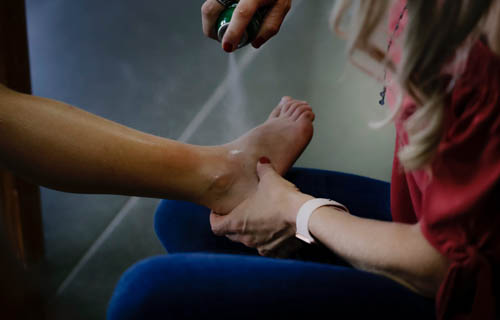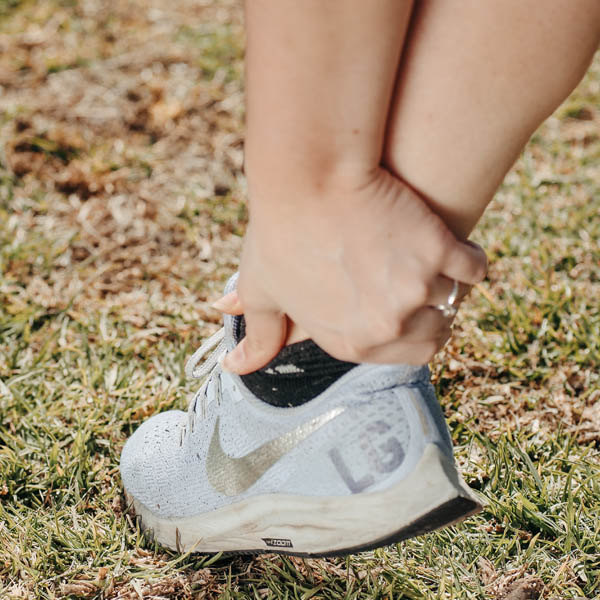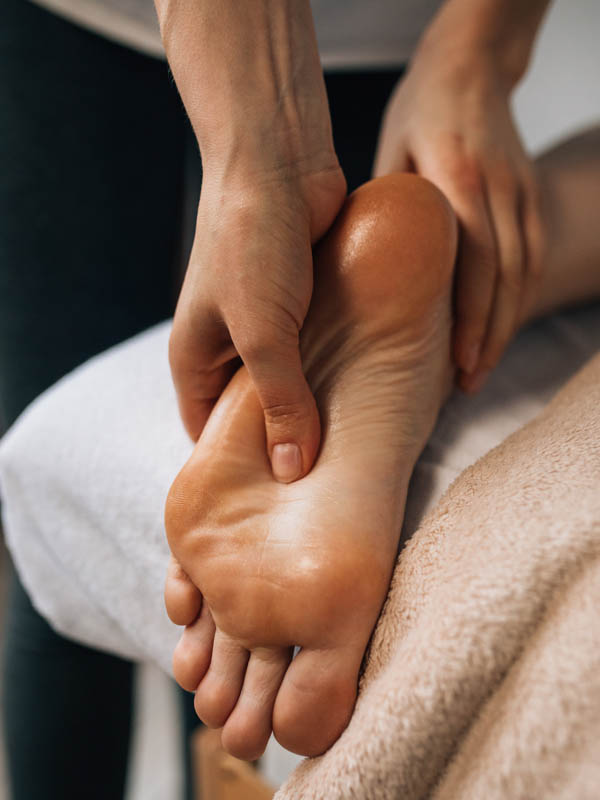Foot Ulcer Treatment
Think about everything you do daily with your feet. They take you from here to there. You can dance, jump, run to catch the bus, and so much more. Having to undergo treatment for your foot ulcers can be painful and impact your activities of daily living. It can affect your financial stability if you have a physical job where you are on your feet most of the time or drive a commercial vehicle.
It is crucial to find an established podiatry clinic that can vary its foot ulcer treatments depending on the individual case. Foot and Ankle Center has been the leading podiatry clinic in Utah for all your foot health needs, including ulcers. Because of Dr. Cameron’s surgical training, he’s the best choice for your foot ulcer treatment. He can prescribe and handle every treatment personally, whether you need clinical or surgical intervention.
Here’s a closer look at what those foot ulcer treatments could look like:
What Are Foot Ulcers?
Foot ulcers are simply open sores that are slow to heal or keep recurring. They result from skin breakdown and are prone to infections. Even if the foot ulcer isn’t apparent on visual inspection, you can feel swelling, burning, and pain where it’s developing. There are three main types of foot ulcers:
- Venous ulcers can develop anywhere below the knee. You can get venous ulcers if you have a history of leg swelling, such as lymphedema or vein conditions.
- Arterial ulcers are also called ischemic ulcers. They can develop anywhere on your feet due to poor circulation.
- Neurotrophic ulcers are commonly known as diabetic foot ulcers on the bottom of your feet.

Causes of Foot Ulcers
The primary cause of foot ulcers requiring treatment is diabetes. The National Institute of Health reports 15 to 25% of people with diabetes will develop a foot ulcer. If your blood glucose levels are elevated and uncontrolled, they can damage blood vessels and nerves all over your body, contributing to blood circulation problems. When this happens in your feet, you can have decreased sensation and won’t feel tight shoes, cuts, or blisters developing. These innocuous issues for a healthy individual will quickly become ulcers.

Another circulation problem contributing to foot ulcers is peripheral artery disease (PAD.) Your blood vessels narrow in your legs and feet. The narrowing reduces your circulation, increasing your risk of ulcers like diabetes. Any diseases affecting circulation, such as heart or kidney disease, can lead to ulcers too.
Nerve damage from other medical conditions or trauma also puts you at risk for foot ulcers. Neuropathy and Morton’s neuroma are a few that can cause pins and needles sensations in your feet. These feelings will make it harder to feel injuries when they occur. Any foot injury can become an ulcer without nerve damage if left untreated. Trauma such as burns, cuts, or puncture wounds can land you in the emergency room for foot ulcer treatment.
In addition to emergency injuries, repeated pressure from poorly fitting shoes or high heels can lead to pressure injuries and ulcers. If you walk or stand for long periods, don’t wear breathable socks, or have shoes that pinch or rub, you are more likely to develop foot ulcers.
Foot malformations such as hammertoes, bunions, or collapsed arches compound other contributing factors like ill-fitting shoes. Alcohol or tobacco use can impact circulation and impede healing, exponentially increasing foot ulcer risk.
The Best Foot Ulcer Treatment Is Prevention
Whether you have a condition that predisposes you to ulcers or you have zero risk factors, follow these prevention tips for the best method of foot ulcer treatment:
- Wear Properly Fitting, Breathable Shoes and Socks
For most foot conditions, the first line of defense is wearing shoes sized correctly for both length and width. Avoid pointed or open-toed shoes, stiff dress shoes, high heels, and flip-flops. Your footwear should have adequate arch and ankle support.
If you are prone to collapsing or high arches, you may need extra arch support in the form of custom inserts or orthotics. When selecting socks, they should be natural fibers like cotton or wool for winter, so they absorb any moisture to keep your feet dry.
- Keep Your Feet Clean and Dry
Make a habit of washing your feet daily with warm water and soap. Dry them thoroughly, taking extra care between your toes to prevent fungal infections.
- Do A Daily Once Over
While washing your feet, perform a routine inspection. Look for any redness or color changes to your skin. Check for swelling, tenderness, or painful spots. Watch out for any cuts, sores, or blisters, so you can treat them before they turn into ulcers.
- Protect and Rest
Avoid walking around barefoot, even indoors. Wear protective footwear such as rain or hiking boots when walking in mud or over uneven surfaces. If you find your feet or legs fatigued easily, rest them frequently. Even if you don’t see any swelling, elevate them when taking a break to reduce inflammation and help promote blood flow back to your heart.
Lastly, if you have diabetes, take care to keep your blood sugar under control. See a podiatrist regularly if you have any common risks for foot ulcers. They can perform foot exams and care to help prevent and treat foot ulcers.
Foot Ulcer Treatment
As with any severe foot condition, foot ulcer treatments vary depending on severity. Podiatrists will assess and classify your foot ulcer based on location, size, depth, underlying cause, and whether you have an infection. They will create a customized plan for your appropriate foot ulcer treatment. Here are some of the interventions you can expect:
Daily Clean and Bandage
Like daily prevention, gently clean and wash the ulcer with warm water and mild soap. You must apply a sterile bandage or dressing to protect the ulcer and promote healing.
Alleviate Pressure
If you have an ulcer-prone area, especially if pressure was the initial cause, you must avoid constricting the space. You may need to use padding, casts, or pressured-relieving dressings while it heals. You may need to change your choice of daily shoes or wear prescription shoes long-term.
Treat the Underlying Medical Condition
If neuropathy, PAD, or diabetes causes your ulcers, you need to work with your medical team to get the condition under control. By treating the disease, you can prevent further ulcers.
Medications
Antibiotics are added to the foot ulcer treatment regime if you have an infection. Ensure you take the entire course of antibiotics to prevent re-infection. Depending on the severity of the ulcer and the required treatments, your doctor may prescribe pain medication as well.

More Serious Foot Ulcer Treatments
When you have an underlying condition that impairs healing or a recurrent foot ulcer, it requires weekly treatments. The podiatrist will assess the wound, identify potential reasons your wound won’t heal, and help create an optimum environment for healing. Interventions may include wound debridement, treatment for foot ulcers, and other wounds like severe burns.
Debridement involves removing dead tissue in and around the ulcer to increase blood flow and promote cell growth and healing. It helps reveal the true nature of the ulcer, reduces pressure on its edges, and reduces the risk of a trapped infection underneath the dead tissue. Afterward, it may appear more significant and bleed, but it will be cleaner and healthier.
Depending on the condition and severity, you may also need to report to the office for bandage changes. Some dressings are infused with ointments to aid infection prevention or debridement. Podiatrists can also perform a surgical debridement, helping circulation and healing more than they can do in their offices. However, surgery is not without its risks.

Foot Ulcer Infection Treatments
Foot ulcers can become infected if you don’t manage them effectively and efficiently.
An infection can develop with pockets of pus, called an abscess, that a doctor may need to drain. If the infection spreads to the underlying fat and skin, it’s called cellulitis, which may require more potent antibiotics.
One of the most severe infections is osteomyelitis, when the infection spreads to the surrounding bones. Tissue death caused by interrupted blood flow is called gangrene and can be as dangerous as osteomyelitis. Both of these conditions can require amputation.
This is only for extreme cases as a last resort. Doctors never consider amputation lightly; typically, doctors reserve it until it becomes a question of life or limb.
Unfortunately, diabetic ulcers are the leading cause of foot amputations. If you don’t seek proper medical treatment for your foot ulcers, the infection will spread to the surrounding tissues and bones, requiring a life-changing amputation.
Protein: A Unique Foot Ulcer Treatment
Protein is crucial for connective tissue healing as it’s one of the building blocks for tissue repair. Regeneration requires large amounts of energy, especially protein. Whether you are trying to prevent foot ulcers or enhance your foot ulcer treatment, eating a protein-rich diet won’t hurt.
Aim for healthy protein sources such as lean meats, milk, eggs, beans, lentils, nuts, and seeds. Tofu, edamame, tempeh, and miso are excellent vegan whole protein sources.
You should eat a variety throughout the day to maximize skin healing benefits. If you struggle to increase your protein consumption, consider protein supplements such as protein bars or shakes.
While protein is one of the more essential nutrients for healing, you need a healthy balanced diet of nutrient-dense foods to maintain your health and well-being.
Your doctor can make recommendations based on your skin’s condition, your body weight, and your lifestyle. You may have a health condition or be taking medication that affects your protein metabolism, so a healthcare professional or registered dietitian can provide the best advice.

Why Choose Foot and Ankle Center for Foot Ulcer Treatments
If you have a medical condition impacting your foot health, it’s crucial to have a doctor that looks at the big picture. Dr. Cameron is a podiatrist who recognizes the importance of diet, lifestyle, and other factors that others may not consider when it comes to the treatment of foot ulcers.
If you feel like you are constantly battling foot ulcers and are not progressing, you need a doctor to help you get where you want to be. Foot and Ankle Center can help you repair your skin and rebuild your foot health better than ever.
Aim for healthy protein sources such as lean meats, milk, eggs, beans, lentils, nuts, and seeds. Tofu, edamame, tempeh, and miso are excellent vegan whole protein sources. You should eat a variety throughout the day to maximize skin healing benefits. If you struggle to increase your protein consumption, consider protein supplements such as protein bars or shakes.
While protein is one of the more essential nutrients for healing, you need a healthy balanced diet of nutrient-dense foods to maintain your health and well-being. Your doctor can make recommendations based on your skin’s condition, your body weight, and your lifestyle. You may have a health condition or be taking medication that affects your protein metabolism, so a healthcare professional or registered dietitian can provide the best advice.
